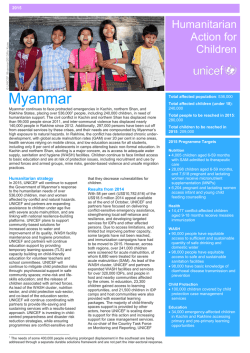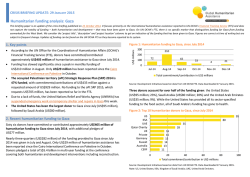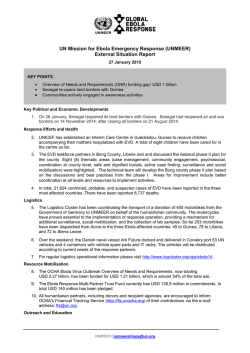
Download PDF
State of Palestine Humanitarian Situation Report Sit Rep #3/2015 – 16-29 January 2015 Highlights Tensions increase in the Gaza Strip, due to the slow path of the reconstruction process, the impact of the winter storm on IDPs and in general the protraction of overall insecurity, including power and water shortages and unsafe living conditions for the people affected by the war. Test of rockets continue as well as ground incursions into the Gaza territory and warning fire by IDF to the fishermen off the Gaza shore. No injured reported. On 27 January, UNRWA announced that due to funding shortfalls, the agency was suspending its cash assistance programme in Gaza for repairs to damaged and destroyed homes and for rental subsidies to the homeless. Some demonstrations of protest were held on 28 January in front of the UNSCO and UNRWA compounds, with reportedly some demonstrators irrupting into the UNSCO compound and provoking some damages to it. As reported to the Security Council, the situation in Gaza has become extremely volatile again and will continue to deteriorate unless a number of critical underlying issues are addressed with both determination and a heightened sense of urgency. The United Nations Country Team continue to urge donors to support humanitarian operations and fulfil the commitments they have made in Cairo for the reconstruction of Gaza. At regional level, the situation experienced some peaks of tensions with an exchange of fire between IDF and Hezbollah in the Golan and Sheba Farm region. An escalation of hostilities at the border between Lebanon and Israel could seriously affect the already vulnerable security situation in the Gaza Strip, The number of IDPs in UNRWA Collective Centers stands at 10,568. On 22 January UNICEF and the Ministry of Social Affairs (MoSA) distributed blankets and warm clothing, to 253 highly vulnerable and needy families across Gaza as part of the UNICEF Gaza Winterization support aiming at reaching vulnerable families as per needs. Two children aged 10 and 16 were injured by ISF during two separate episodes, in Balata and Ramallah; a girl aged 14, detained by Israel since 31 December for stone-throwing, has been sentenced to 2 months of detention and a fine of 6,000 shekels (1,528). 1 Gaza conflict 8 July – 26 August 2014 Situation in Numbers 539 children killed (Protection Cluster, 4 December 2014) 2,257 total deaths (Protection Cluster, 4 December 2014) 54,000 children homeless (OCHA, 4 September 2014) 2,956 children injured (Protection Cluster, 4 December 2014) 1,500 children orphaned (Protection Cluster, 1 September 2014) 89 entire families killed (OCHA, 25 August 2014) UNICEF HAC 2015 Funding Need - Total $37,300,307 Million UNICEF HAC 2015 Funding Need – Gaza $27,411,129 Situation Overview On 27 January, UNRWA announced that it has been forced to suspend its cash assistance programme in Gaza to tens of thousands of people for repairs to damaged and destroyed homes and for rental subsidies to the homeless. Over 96,000 Palestine refugee family homes were damaged or destroyed during last summer’s conflict and the total funding required to address that need is USD 720 million. To date, UNRWA has received only USD 135 million in pledges, leaving a shortfall of USD 585 million. While some funds remain available to begin the reconstruction of totally destroyed homes, the Agency has exhausted all funding to support repairs and rental subsidies. The announcement provoked waves or resentment amongst the beneficiaries, who gathered for a demonstration on 28 January in Gaza City in front of the UNSCO compound, provoking some damages to the building. No one was injured. Robert Serry, Special Coordinator to the Middle East, announced UN will conduct an urgent review of operations in Gaza in light of the increasing incitement against the United Nations in Gaza. According to a recently released report by the UN High Commissioner for Human Rights, Prince Zeid Ra'ad Zeid alHussein, both Israeli and Palestinian parties have failed to adequately investigate the full range of apparent human rights violations committed during the Gaza war last summer, especially grave violations against children. On 27-28 January, IDF and Hezbollah had an exchange of fire at the border between Lebanon and Israel, with 2 Israeli soldiers and a Spanish-national UNIFIL peacekeeper reportedly killed. A potential escalation of hostilities at the border between Lebanon and Israel could seriously affect the already vulnerable security situation in the Gaza Strip, which is already tensed due to the disruption of the aid delivery and the delays in the post-war reconstruction. Violent episodes involving children continue: on 26 January, a 10 years-old boy was arrested by under covered police in the East Jerusalem neighborhood of Shufat; on 27 January morning a boy 16-year-old was shot in the leg by IDF during clashes near Joseph's Tomb near Balata refugee camp in Nablus in the northern West Bank. The situation remain dire for a 14-year-old girl from Betin, in Ramallah, who has been detained since 31 December with the accusation of stone-throwing. On 22 January, the Israeli military court in Ofer sentenced to two months in prison and fined her ILS 6,000 ($1,528). Protection of rights of children in Israeli military detention is one of the priority areas of intervention for UNICEF SoP. Rafah border opened in both directions for three days on 20-21-22 January, allowing the crossing of more than 2,000 individuals in and out the Gaza Strip. According to the Gaza ministry of Interiors, the Egyptian government has opened the crossing a total of 88 days non-consecutively since last June's mass protests which led to Morsi's ouster. The Rafah border is a vital crossing for the movement of goods and people throughout the Gaza Strip since the Israeli blockade in place as of 2007 and an easing of the crossing would benefit the living conditions of the Gazan population, including children. The number of Internally Displaced Persons (IDPs) in 15 UNRWA Collective Centers (CCs) has decreased to 10,568 as of 28 January. At least 539 Palestinian children were reported killed as a result of the hostilities in Gaza between 8 July and 26 August, 2014. The child fatalities include 339 boys and 200 girls. 81% of them, or 440 children, were killed during the period of the IDF ground incursion, in the course of 20 days between 17 July and 5 August, this translates to 22 children killed on average per day. At least 2,956 Palestinian children were reported injured or maimed between 8 July and 26 August 2014. In total, a reported 11,100 Palestinians have been injured or maimed, of which children make up 26 per cent. The In the caravan camp of Khuzaa, Khan Younis, displaced children children injured include 1,938 boys (66%) and 1,018 are affected by the winter storm. girls (34%), aged between two days and 17 years. 2 Bring colour to a Dark World! Beauty in Gaza: adolescents and children joined forces to make Gaza City's harbour look livelier. They painted the concrete slabs and rocks of the harbour with vibrant colours - a sign of hope in the midst of ongoing blockade and destruction left by this summer's war. The young artists want to instil a sense of hope for them and all families who come to the harbour with their children to enjoy a fresh breath of air. This youth initiative, supported by UNICEF with funds from the Netherlands, is coordinated by partner TAMER Institute for Community Education. #gaza4children Summary Analysis of Programme Response Education and Adolescents The first and second phase of the e-voucher programme for shoes and school uniforms have been completed. The programme, which started on 28 October 2014, benefitted 12,482 children, who redeemed the items through the e-vouchers. The programme foresees a third phase which will be launched after the verification of the beneficiary list, which is ongoing. The skills development training programme, implemented by UNICEF in coordination with TAMER, MAAN, Al Nayzak, and Save Youth Future Society continued during the reporting period. Topics covered include creative and critical thinking, communication, problem Young artists in Gaza paint the wall of the harbor as part of a youthsolving, team work and other non-cognitive led initiative coordinated by TAMER and UNICEF aimed at skills. At least 17,032 adolescents have been strengthening social cohesion and hope in the aftermath of the war reached since the beginning of the programme, with 1,114 adolescents reached during the reporting period. The final ceremony for the Badir 2004 project implemented by Al Nayzak, UNICEF partner, as part of the Gaza Emergency Response, was held on 25 January and was attended by the UNICEF Special Representative, the Minister of Education and several school principals. As part of the project, 75 adolescents and youth volunteers co-facilitated 14 weekly sessions on remedial and extracurricular education, and psychosocial activities, reaching 3,138 children in 25 schools. Through the utilization of innovative and interactive tools, based on a well-developed training, children and adolescents received psychosocial support and gained knowledge to take active participation in the society. As a result, besides school sessions, the 75 adolescents are implementing 20 social initiatives in their communities. 3 Child Protection Winter storm response: UNICEF proceeded with the distribution of winter items in Gaza, in consultation with MoSA and the Shelter cluster. On 22 January, 235 highly vulnerable and needy families received blankets and warm clothing. All five distribution sites were supervised by UNICEF and MoSA. The delivery of psychosocial support to children and caregivers in Gaza is ongoing. UNICEF and Palestinian Centre for Democracy and Conflict Resolution (PCDCR) reached 3,236 Children (1,606 girls, 1,630 boys) with psychosocial support in the reporting period. Additionally, 1,256 caregivers (655 females and 601 males). In total is 34,170 (16,681 girls and 17,489 boys) have received psychosocial support since 15 September. Distribution of warm clothes and blankets to vulnerable families Additionally, 7,206 caregivers (3,600 females and in Gaza as part of the UNICEF Winter Storm Response 3,606 males) were reached through awareness raising activities. Twenty-three Family Centres are providing core child protection services, psychosocial assessment, ERW risk education and outreach to vulnerable children and families. Caregivers of children attending the centers are also targeted through awareness raising sessions on child protection and ways to support the psychosocial development of their children. Thirteen family centers managed by Ma’an Development Center are currently providing child protection services to 19,454 children (11,048 girls and 8,406 boys). Additionally, 6,020 caregivers (4,377 females and 1,643 males) have increased awareness on child protection. The remaining ten Family Centers are managed by Tamer institute for Community Education. The centers are serving a total number of 9,387 children (4,457 girls and 4,930 boys) and 1,632 caregivers (1,302 females and 328 males). Fifty-five members of the UNICEF-WHO led Mental Health Psychosocial Working Group reached 75,017 children through structured group and individual counselling activities since the end of the hostilities. In addition 8,024 adults have been reached with structured group and individual counselling activities. Distribution of warm clothes and blankets to vulnerable families in Gaza as part of the UNICEF Winter Storm Response 4 UNICEF, in cooperation with NRC, UNFPA, UNICEF and UN Women held the second phase of the Training of Trainers (TOT) on Case Management. The TOT focused on practicing case management skills with in-depth case studies, as well as providing a half-day session to self-care within a Caring-for-Carers framework. Participants included staff from MOSA, MOEHE, national and international NGOS. They developed a training plan with a view to rolling out the training to case managers in Gaza over the coming months. The UNICEF-led Child Protection Working Group has documented Child Protection programme implementation by 11 partners, reaching 34,542 children and 3,717 adults since the end of the conflict. Water, Sanitation and Hygiene During the reporting period, UNICEF supported the distribution of 140 tons of chlorine and chemicals for pipedwater disinfection to all the WASH facilities, water wells and desalination units in Gaza. The intervention will benefit the entire population of the Gaza Strip, 1.8 million individuals, half of which are children. The interventions of rehabilitation and upgrading of water and wastewater networks are ongoing in Khan Younis, Rafah and Middle Area, benefiting 3,000 people (50 per cent children). UNICEF is procuring 6,000 jerry cans with water taps to be distributed to 6,000 affected families in the eastern border areas of all Gaza Strip, as part of the strategy to increase the storage of drinking water. UNICEF in partnership with the Palestinian Hydrology Group (PHG) is planning to distribute safe drinking water in installed filling points in Shajaeya, Beit Hanoun and Khuzaa, targeting 3,000 families affected by the conflict. Child Health & Nutrition Five tons of medical and non-medical consumables were delivered to the Ministry of Health warehouses in Gaza during the reporting period. During the same period, UNICEF-supported MoH Community Health Workers (CHWs), conducted breastfeeding awareness-raising sessions for 853 lactating mothers by thus reaching the total of 22,756 women in 68 Education sessions; awareness-raising session about communicable diseases (NCD) and vaccination were conducted to 927 women and 62 children, reaching the total of 1,710 men, 19,985 women and 3,948 children. 15 participants, doctors and nurses, strengthened their skills during a training on the Community-based Management of Acute Malnutrition (CMAM) guidelines, organized by the Ministry of Health and UNICEF. The MoH and the Near East Council of Palestinian women and children attend an instruction class on Churches (NECC) teams continue to provide breastfeeding for mothers temporarily living in shelters post-natal care at home and in shelters, reaching 327 women during the reporting period. MoH teams continue to provide post natal care at homes. Since 8 July 2014, UNICEF has reached 5,202 mothers and their newborns in conflict-affected areas, thus exceeding the target of 3,250 mothers. Humanitarian leadership and coordination UNICEF, as part of the UN Country Team, coordinates with the Government of National Consensus to support its role in humanitarian response, early recovery and reconstruction. UNICEF is co-leading a new Nutrition Sub Group together with Ministry of Health (MoH) in both West Bank and in Gaza. In cooperation with the Government and other UN partners, UNICEF has participated extensively in an ongoing Palestinian Detailed Needs Assessment and will continue to support the development of the recovery framework and strategy. UNICEF leads the Child Protection Working Group and affiliated groups for mental health and psychosocial sevices (MHPSS), and for monitoring and reporting of grave violations against children (MRM - Children and Armed Conflict reporting mechanism). These groups have been merged to maximise coordination of child protection responses during the emergency. UNICEF also leads the UN Theme Group on Social Protection. UNICEF continues to lead the WASH cluster and co-lead the Education cluster with Save the Children, both in Gaza and at the national level, with dedicated staff capacity. 5 Funding UNICEF SoP would like to stress the importance of meeting the urgent humanitarian needs of affected families, which will also contribute to reduced tensions and increased stability. In order to achieve this, additional funds are required to expand existing programmes that are being successfully implemented on the ground. UNICEF wishes to express its deep gratitude to all public and private sector donors for the contributions and pledged received, which have made the current response possible. UNICEF would especially like to thank National Committees and donors who have contributed ‘un-earmarked’ funding. ‘Un-earmarked’ funding gives UNICEF essential flexibility to direct resources and ensure the delivery of life-saving supplies and interventions to where they are needed most – especially in the form of longer-term and predictable funding and in strengthening preparedness and resilience building. Continued donor support is critical to continue scaling up the response. Funding requirements (as defined in revised humanitarian Gaza Crisis Appeal- September – December 2014) Appeal Sector Requirements Funds received* Education 17,313,401 WASH Funding gap $ % 2,329,407 14,983,994 87% 11,876,216 4,000,524 7,875,692 66% Child Protection 5,093,875 2,257,366 2,836,509 56% Health & Nutrition 4,729,536 1,549,264 3,180,272 67% 865,269 99,450 765,820 89% 39,878,297 10,236,010 29,642,287 74% Cluster Coordination Total (USD) Note 1: Total cash on hand is $15,185,564 of which $10,236,010 is funding received against the appeal for year 2014, and $4,949,554 is budget carried forward from prior years and reallocated to the SoP office. Note 2: The table does not include the Emergency Programme Funds loan received from UNICEF HQ of $4 million. Note 3: The total includes a maximum recovery rate of 8%. The actual recovery rate on contributions will be calculated in accordance with UNICEF Executive Board Decision 2007/6 dated 9 July 2009. Funding requirements (as defined in the Humanitarian Action for Children 2015, for both West Bank and Gaza) Appeal Sector Requirements* Gaza West Bank – incl. East Jerusalem Education WASH (incl. Cluster Coordination) Child Protection 8,069,771 6,608,499 1,461,273 14,773,656 10,592,526 4,181,130 9,187,560 5,808,294 3,379,266 Health & Nutrition 5,269,320 4,401,810 867,510 37,300,307 27,411,129 9,889,179 Total (USD) Next Sit Rep: 26th February 2015 Costanza Pasquali Lasagni, Reporting Specialist, UNICEF, SoP, Jerusalem, Phone: +972 (0)2 584 0455, mobile : +972 (0)54 778 7685, email : [email protected] http://www.unicef.org/oPt/, https://www.facebook.com/unicefstateofpalestine 6
© Copyright 2025
![Current appeal [PDF]](http://s2.esdocs.com/store/data/000456387_1-84443a4282546a8fcd8c29f2bdd10a65-250x500.png)
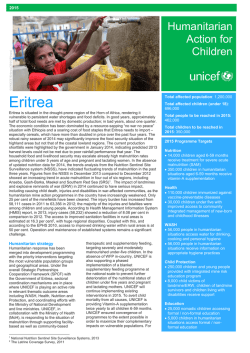
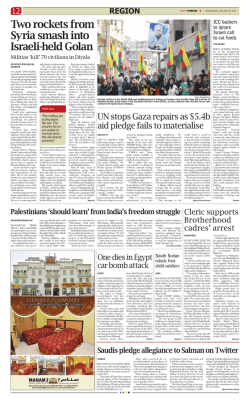
![Current appeal [PDF]](http://s2.esdocs.com/store/data/000476858_1-ff5bfc045afda14d4551c905d8c862b7-250x500.png)
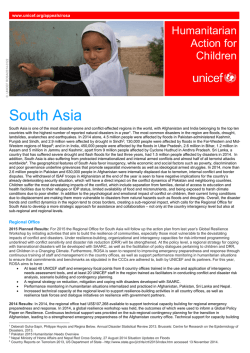
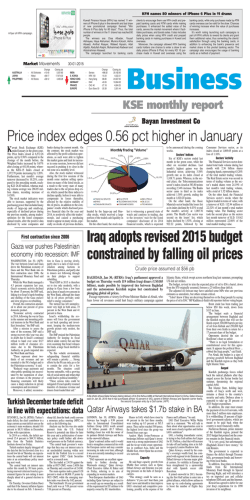
![Current appeal [PDF]](http://s2.esdocs.com/store/data/000470301_1-1a2ac0338c7b87d842a9839e11e746d1-250x500.png)
